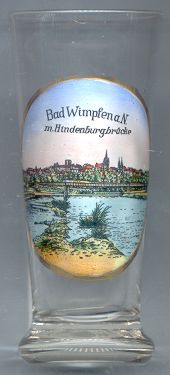

|
| DEUTSCHLAND | GERMANY |
| Bundesland: Baden-Württemberg | |
| Regierungsbezirk: Stuttgart | |
| Landkreis: Heilbronn |
 Bad Wimpfen is situated at an elevation of 217 m on the river Neckar north of Heilbronn. The earliest traces
of settlements go back to at least the 5th century BC. The name "Wimpfen" seems to be of Celtic origin and is tentatively explained as "walled mountain",
possibly refering to an ancient Celtic stronghold which, however, has not been found yet. The oldest archeological trace of the Romans is
an oak beam which must have been a part of a bridge and which was dated dendrologically to the year AD 85. The region was christianized during
the Frankish period in or after the 7th century. A document of 965 confirms the ownership of the region by the bishops of Worms.
Bad Wimpfen is situated at an elevation of 217 m on the river Neckar north of Heilbronn. The earliest traces
of settlements go back to at least the 5th century BC. The name "Wimpfen" seems to be of Celtic origin and is tentatively explained as "walled mountain",
possibly refering to an ancient Celtic stronghold which, however, has not been found yet. The oldest archeological trace of the Romans is
an oak beam which must have been a part of a bridge and which was dated dendrologically to the year AD 85. The region was christianized during
the Frankish period in or after the 7th century. A document of 965 confirms the ownership of the region by the bishops of Worms.
The Canons' monastery was founded in the 12th century and became immediate to the empire. The imperial palatinate of Emperor Friedrich I (Barbarossa) is first documented in 1182 and thus Wimpfen became one of the centre of the empire. Around 1300 the village Wimpfen obtained the status of a Free Imperial town, and both town and monastery for centuries remained in opposition. After the 15th century the wealth of the town declined. Although the Empire favoured Catholicism, most inhabitants of Wimpfen had converted to the Protestant faith during the late 16th century. The Thirty Years' War (1618–1648) was disastrous: at the end of the war only about a tenth of its population remained and only gradually could grow again, but never became more than a small rural town. Both town and monastery finally lost the formal status of being immediate to the empire in 1802, and became part of Hesse-Darmstadt in 1803.
After the Napoleonic Wars the modern development of Wimpfen began with the opening of the saline Ludwigshalle. The first spa hotel (Mathildenbad) was opened in 1835, which became a renowned attraction for tourists from all over Europe. The spa was further boosted by the opening of the railroad from Heilbronn via Wimpfen to Heidelberg. In 1930 the predicate "Bad" ('spa') was added to the town's name. Until the early 20th century Bad Wimpfen remained an exclave of the Grand Duchy of Hesse-Darmstadt situated between Baden (see Baden-Baden) and Württemberg. After World War I the town was attached to the state of Baden although the population was divided between those who wanted to remain with Hesse and those who favoured becoming part of Württemberg. In 1951/52 Bad Wimpfen indeed was attached to the district Heilbronn in the new state of Baden-Württemberg.
the bridge shown in the picture on glass no. 1714 [left] is identified as
 Hindenburgbrücke
Hindenburgbrücke
![[scale]](lineal.jpg)